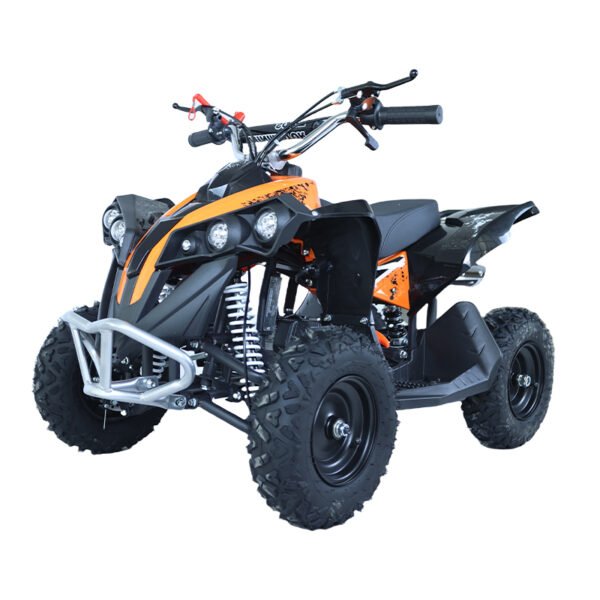
How to Maintain Your Chinese ATV
How to Maintain Your Chinese ATV: A Complete Guide
Introduction to Chinese ATV Maintenance
Owning a Chinese ATV can be a thrilling experience, offering you the power and capability to explore rough terrains and enjoy outdoor adventures.
However, to keep your ATV in top shape and ensure it performs reliably, consistent maintenance is essential.
Chinese ATVs, like any off-road vehicle, require regular care to handle the wear and tear that comes with intense rides.
This guide will walk you through key steps for maintaining your Chinese ATV, from routine checks to specialized care, ensuring it stays dependable for every adventure.
Why Regular Maintenance is Crucial
Keeping up with maintenance is not only about extending the lifespan of your ATV—it’s also about safety and performance.
Regular upkeep helps prevent minor issues from turning into costly repairs and improves fuel efficiency.
When you maintain your ATV properly, it performs smoothly, giving you peace of mind while you’re out on challenging trails.
Neglecting these steps can lead to unexpected breakdowns or even accidents, especially in remote areas where help isn’t easily accessible.
Understanding Your ATV’s Manual
Your ATV’s manual is one of the best resources you can rely on for maintenance tips and guidelines.
Each model has specific recommendations regarding oil type, spark plug specifications, and tire pressure, among other details.
Familiarize yourself with this manual as it outlines the necessary intervals for each maintenance task.
Following the manufacturer’s instructions can prevent you from using incorrect parts or fluids, which could otherwise harm your ATV’s performance.
Essential Tools for ATV Maintenance
Having the right tools on hand can make a huge difference in the ease and efficiency of your maintenance routine.
Here are some must-have tools:
- Wrenches and Screwdrivers: Essential for tightening bolts and screws.
- Socket Set: To remove spark plugs and other components.
- Oil Filter Wrench: Helps remove and replace oil filters.
- Tire Pressure Gauge: Ensures your tires are inflated correctly.
- Battery Charger: To keep your battery charged during periods of inactivity.
These tools allow you to perform most routine checks and fixes yourself, saving you trips to the mechanic and giving you more control over your ATV’s condition.
Routine Checks Before Every Ride
Before heading out, make it a habit to do a quick inspection of your ATV.
This pre-ride check helps you spot issues early, reducing the likelihood of breakdowns mid-adventure. Focus on these areas:
- Tire Pressure and Condition: Check for punctures or excessive wear.
- Oil Level: Ensure it’s topped up and that there are no leaks.
- Brakes: Confirm they’re responsive and inspect for signs of wear.
- Lights and Signals: Ensure all lights work properly, especially if you plan to ride in low-light conditions.
Completing these checks before each ride can save you from potential mechanical problems and improve the overall safety of your ATV.
Engine Maintenance and Oil Changes
One of the most critical aspects of ATV maintenance is caring for the engine.
Regular oil changes help prevent dirt buildup and keep your engine running smoothly.
Selecting the Right Oil
Choosing the right oil is vital for your ATV’s performance.
ATVs often require a specific type of oil with a unique viscosity rating.
Refer to your manual to determine which oil suits your engine best, typically 10W-40 or 10W-30 for most models.
Using a high-quality oil designed for off-road vehicles is always a smart choice.
Changing the Oil Step-by-Step
- Warm Up the Engine: Start your ATV and let it run for a few minutes to heat the oil. This helps it drain easier.
- Drain the Oil: Locate the drain plug underneath the engine and remove it carefully. Let the oil fully drain.
- Replace the Oil Filter: Use an oil filter wrench to remove the old filter and replace it with a new one, tightening it as recommended.
- Refill with Fresh Oil: Add the specified amount of new oil, then check the oil level with a dipstick to ensure it’s correct.
Performing regular oil changes every 30-40 hours of riding is ideal, especially if you frequently ride in dusty or muddy conditions.
Air Filter Care
The air filter in your ATV prevents dust and debris from entering the engine, which can be especially important for Chinese ATVs used in off-road environments.
How to Clean the Air Filter
- Remove the Filter: Carefully take out the air filter, which is usually located near the carburetor.
- Clean or Replace: For foam filters, wash with mild soap and water, then let it dry completely before oiling it lightly. For paper filters, replacement is necessary once they become too dirty.
When to Replace the Air Filter
Most air filters should be replaced after every 10-15 hours of riding, or sooner if you notice a significant build-up of dirt.
A clogged air filter restricts airflow, reducing your ATV’s power and efficiency.
Battery Maintenance for Longevity
ATV batteries are generally long-lasting, but regular checks are essential to keep them functioning well, particularly for Chinese ATVs that may have more sensitive electrical systems.
Checking Battery Health
Inspect the battery terminals for any corrosion, which can interfere with connections.
Clean them with a wire brush if needed. Make sure the battery is fully charged, especially during colder months when batteries tend to drain faster.
Charging and Storage Tips
Invest in a trickle charger if you plan to store your ATV for extended periods.
This keeps the battery from losing charge and prevents damage.
Disconnecting the battery during long storage periods also helps reduce wear.
Inspecting and Replacing Spark Plugs
Spark plugs are small but crucial components in your ATV’s ignition system.
Faulty spark plugs can cause hard starts or misfires, especially after intense use.
- Locate the Spark Plug: Usually found at the top of the engine, covered by a small wire.
- Check for Wear: If the spark plug looks blackened or worn, replace it to ensure your ATV starts smoothly and runs efficiently.
Changing spark plugs every 25-30 hours of riding is generally recommended for optimal performance.
Brake Maintenance for Safety
Brakes are one of the most important safety features on any vehicle, and your ATV is no exception.
Poor brake maintenance can lead to accidents, so regular inspections are essential.
Types of Brakes and Their Maintenance Needs
Chinese ATVs typically come with disc or drum brakes. Each type requires slightly different care:
- Disc Brakes: Check for brake fluid levels and inspect the pads for wear.
- Drum Brakes: These can accumulate dust, so clean them regularly to ensure they function correctly.
Brake Pad Replacement Process
When the pads start to wear down, it’s time for a replacement:
- Remove the Brake Caliper: Use a wrench to unbolt the caliper.
- Remove and Replace Pads: Take out the old pads and insert new ones, ensuring they’re securely in place.
- Reattach the Caliper: Bolt it back in place, and check the brakes to make sure they’re responsive.
Chain, Belt, and Drive Maintenance
Your ATV’s drive system, whether it’s chain, belt, or shaft-driven, plays a central role in transferring engine power to the wheels.
This part endures significant wear, especially on off-road terrains, making routine inspection and maintenance essential.
- Chain-Driven ATVs: Inspect the chain for any signs of rust, wear, or looseness. If the chain is loose, adjust it according to the tension specifications outlined in your manual. Apply a chain lubricant periodically, particularly after riding in wet or muddy conditions, to prevent rust and reduce friction.
- Belt-Driven ATVs: Check the drive belt for any signs of cracking or fraying, which can lead to sudden breakdowns. If you notice any significant wear, it’s best to replace the belt promptly. Clean the surrounding area to prevent debris from causing belt damage.
- Shaft-Driven ATVs: This type requires less frequent maintenance, but the shaft should still be lubricated periodically to keep it functioning smoothly. A quick inspection for leaks or any abnormalities can help maintain its durability.
Suspension and Shocks Check
The suspension system in your ATV is key to handling rough terrains comfortably.
Over time, shocks and springs can wear out, leading to a rougher ride and impacting handling.
- Inspecting the Shocks: Look for oil leaks around the shock absorbers, as leaking oil may indicate the need for a replacement.
- Testing Suspension: Press down on the ATV’s frame near the shocks and observe how it rebounds. A quick rebound is a good sign, while a slow return may indicate worn shocks.
Regularly inspecting your suspension can enhance comfort, reduce wear on other components, and ensure better control over the vehicle.
Tire Inspection and Pressure Adjustment
Tires are your ATV’s point of contact with the ground, so they endure a lot of stress.
Proper tire maintenance ensures better grip, stability, and safety.
- Tire Condition: Check each tire for punctures, cracks, or excessive wear. If tread wear is uneven, it might be a sign of alignment issues or low tire pressure.
- Adjusting Tire Pressure: Keeping the right pressure helps maximize traction. Use a tire gauge to check and adjust pressure according to the recommended levels in your manual, typically between 4-7 psi for ATVs. Remember, low tire pressure is beneficial for traction in rough terrains but can compromise stability on flat surfaces.
Tire maintenance not only improves performance but also minimizes the chance of punctures while riding.
Keeping Your ATV Clean
Cleaning your ATV regularly doesn’t just keep it looking good—it also removes debris and dirt that could harm various components over time.
Here’s a breakdown of the best cleaning practices:
Best Cleaning Practices
- Use a Pressure Washer Carefully: Avoid directly spraying water on the electrical components, air filter, or fuel system. A gentle spray helps remove stubborn mud and dirt without damaging sensitive parts.
- Mild Detergent for Bodywork: Use a mild detergent mixed with water for scrubbing the body panels and wheels. Avoid harsh chemicals that might harm the paint or plastic.
- Dry Completely: Ensure your ATV is fully dried, especially if you’ve cleaned near electrical connections. Use a cloth to remove any excess water and prevent rust from forming on metal parts.
Areas to Focus On
Pay special attention to hard-to-reach areas where mud tends to accumulate, like under the wheel wells and around the suspension system.
Keeping these spots clean helps prevent corrosion, ensuring that your ATV stays in peak condition.
Winter Storage and Seasonal Maintenance
If you plan to store your ATV during the winter or for an extended period, there are a few steps you should take to ensure it remains in top condition.
- Drain or Stabilize Fuel: Fuel can degrade over time and cause damage to the carburetor or fuel injectors. Either run the ATV until the fuel tank is empty or add a fuel stabilizer to preserve it.
- Disconnect the Battery: Store the battery separately in a dry, cool place and connect it to a trickle charger to keep it from draining completely.
- Elevate the ATV: To prevent flat spots on the tires, use a stand or lift to keep the ATV’s weight off the tires during storage.
Taking these steps can make a significant difference when it’s time to bring your ATV back out for a new season, ensuring it’s ready to go without unexpected issues.
Tips for Troubleshooting Common Issues
Every ATV owner will likely encounter common mechanical issues from time to time. Here are a few tips to help you diagnose and fix typical problems:
- Difficulty Starting: This issue may stem from a dead or weak battery, a dirty air filter, or a worn spark plug. Check each of these components and replace as necessary.
- Poor Acceleration: Often due to issues with the fuel system or a clogged air filter. Make sure the air filter is clean, and check the fuel line for any obstructions.
- Overheating: If your ATV is overheating, check for low coolant levels and ensure there is no blockage in the radiator. Dirty oil can also contribute to this issue, so an oil change may help.
Addressing these minor issues promptly can save you from bigger repairs and ensure a safer ride.
The Importance of Professional Inspections
While most maintenance tasks can be done at home, it’s wise to schedule a professional inspection at least once a year.
A trained mechanic can spot potential issues that might go unnoticed and perform comprehensive tests on the engine, brakes, and electrical systems.
These inspections ensure that your ATV remains reliable, safe, and ready for the long haul.
Conclusion
Maintaining a Chinese ATV requires a bit of dedication, but with regular care, you can extend the life of your vehicle and ensure it’s always ready for the next adventure.
From routine pre-ride checks to seasonal maintenance, each step plays a vital role in keeping your ATV running smoothly.
Investing time and effort into maintenance not only improves performance and safety but also prevents costly repairs down the road.
So, grab your toolkit, keep up with regular inspections, and enjoy the thrill of riding with confidence.
FAQs on Chinese ATV Maintenance
- How often should I change the oil in my Chinese ATV?
- It’s recommended to change the oil every 30-40 hours of riding or at least once every three months, whichever comes first.
- What’s the best way to clean my ATV after a muddy ride?
- Use a pressure washer on a low setting to remove mud, avoiding direct sprays on the electrical components. Finish with a mild detergent and rinse thoroughly.
- Why does my ATV struggle to start in cold weather?
- Cold weather can affect battery performance. Try warming up the engine and check if the battery is fully charged before riding in colder conditions.
- How do I know when to replace the brake pads?
- Inspect the pads for wear regularly. If the thickness is less than 1/8 inch, it’s time for a replacement to ensure safe braking.
- Is it necessary to disconnect the battery for long-term storage?
- Yes, disconnecting the battery prevents it from draining and helps prolong its life. Alternatively, you can use a trickle charger to maintain battery charge during storage.


















Finnian O’Connor
The troubleshooting tips for common issues like difficulty starting or poor acceleration are invaluable. They help me quickly diagnose and fix problems without professional help.
Elspeth Macintyre
I love how the article highlights the importance of cleaning the ATV after muddy rides. Using a pressure washer carefully and focusing on hard-to-reach areas prevents long-term damage.
Tadej Kovac
The guide’s detailed explanation of brake maintenance is reassuring. Knowing how to inspect and replace brake pads ensures safer rides, which is crucial for off-road adventures.
Sweta Chatterjee
The advice on battery maintenance is timely. I wasn’t aware of the importance of using a trickle charger during long storage periods to preserve battery life.
Darian Mckee
As a new ATV owner, I found the information on air filter care incredibly useful. Cleaning or replacing the air filter regularly makes a big difference in performance.
Anika Sorensen
The section on essential tools is spot-on. Having the right tools like wrenches, a socket set, and a tire pressure gauge makes maintenance tasks much more manageable.
Clemens Riedel
I appreciate the emphasis on routine checks before every ride. It’s a great reminder to inspect tire pressure, oil levels, and brakes to prevent mid-ride breakdowns.
Jordana Wexler
This guide is incredibly helpful for maintaining my Chinese ATV. The step-by-step instructions for oil changes are easy to follow and give me confidence to do it myself.